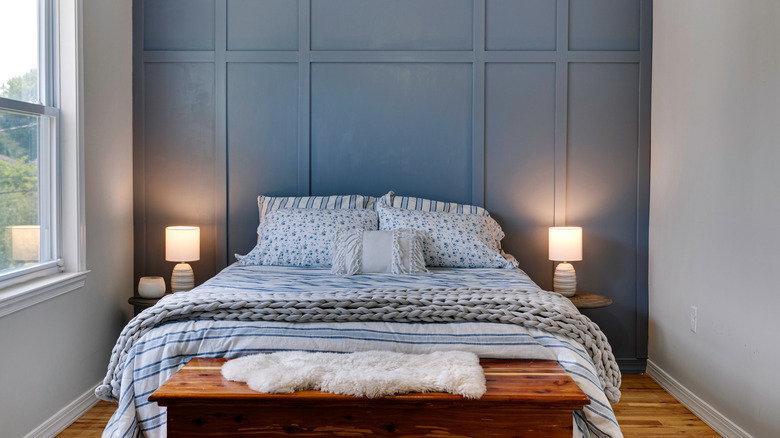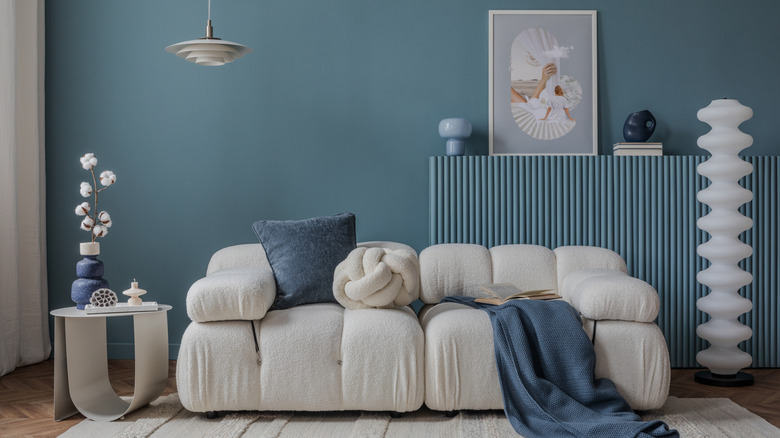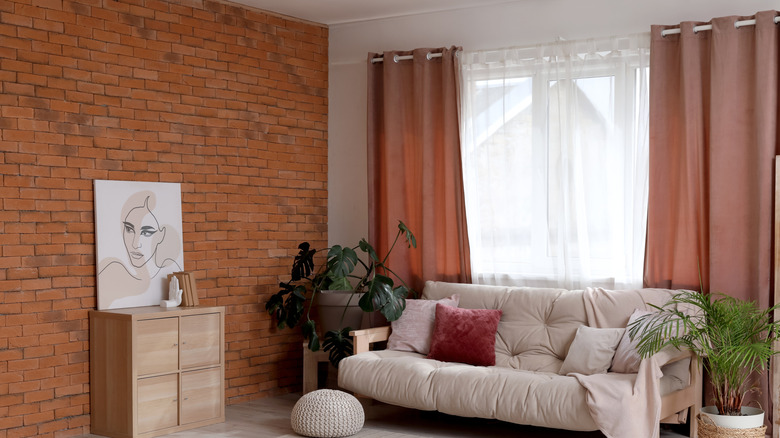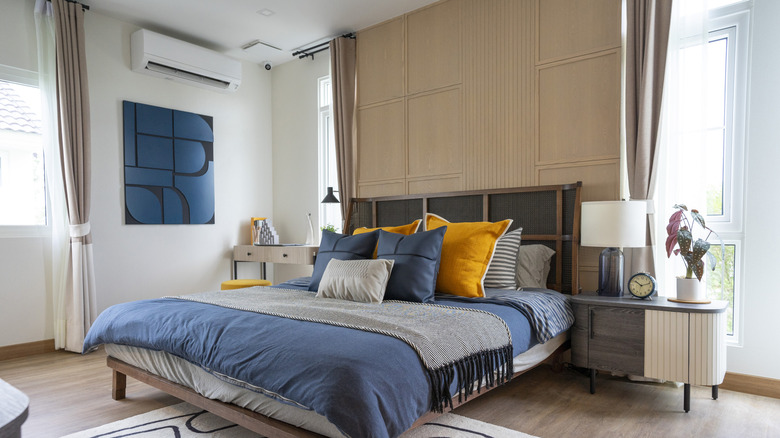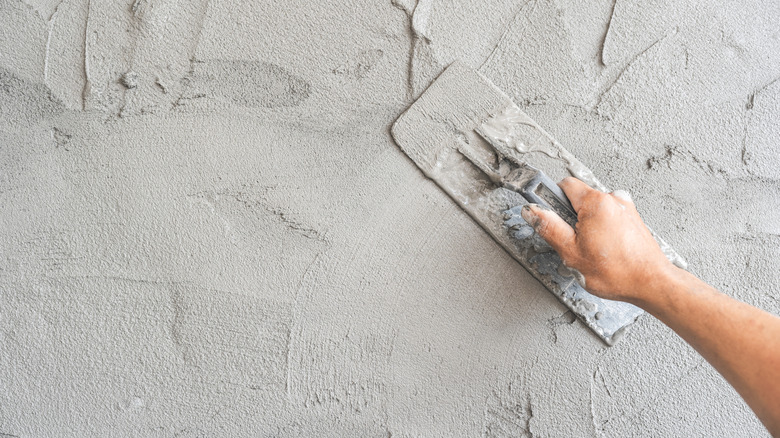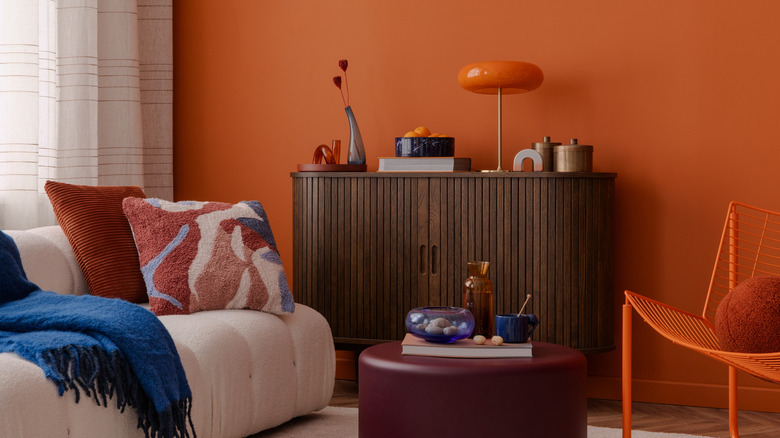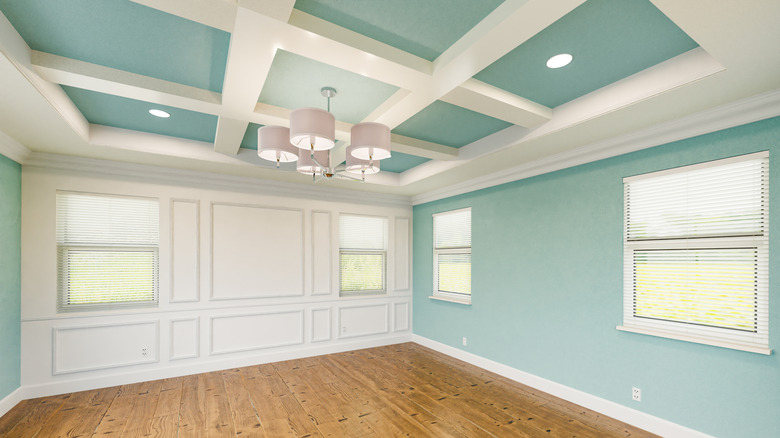Essential Tips & Tricks For Creating The Perfect Accent Wall
We may receive a commission on purchases made from links.
If you're not happy with the overall design and visual appeal of one of the rooms in your home, there are several steps you can take to enhance the space's look. One thing you might be considering is adding an accent wall. Creating one is precisely what it sounds like: turning one wall of the room into a focal point of the space.
There are a ton of trendy accent walls that can bring your home to life. However, how do you create one that doesn't feel too stark or jarring? Is there a way to help the wall blend in with the rest of the room, making it feel more seamless rather than choppy? To learn more, we reached out to professional designers and asked them to share their most essential tips and tricks. Before you read through their exclusive quotes, keep this general word of advice from Todd Howard Ezrin, the principal of TOBE DesignGroup, in mind: "An accent wall should elevate a space, not shout for attention. The best ones are intentional and integrated—anchoring the room without overwhelming it." Here's how to create one that will do just that.
Think of the function of the room to decide which wall to accent
If you want to add an accent wall, it is important to choose the right wall to highlight. Not just any will do. To help narrow it down, Ezrin recommends thinking about where your eyes naturally go upon entering the space. If you're not sure where most people would first look, try leaving the room and walking back into it. Pay attention to the first place your eyes go or what you notice first, as that space (or the surface behind it) is likely a good candidate for an accent wall.
He also recommends considering the function of the room and highlighting its main piece of furniture to help narrow down the options. "In a bedroom, that's often behind the bed. In a living room, maybe behind the sofa or fireplace." If the focal point of the room is less obvious, such as in a kitchen, an office, or another common area, Ezrin says, "We consider how people move through the space and where we want to create a moment of pause or interest."
Choose a wall without any distractions
Selecting the right accent wall in your room is crucial. To narrow the scope, Jennifer Guerin, the owner of JG Color Studios and a certified color consultant, recommends zeroing in on a section without any distractions. She says, "Your design will be most effective if the wall is symmetrical and flat, without any windows, doors, or multiple angles, as these elements can be distracting."
A wall that lacks symmetry can have a negative impact on the overall feel of the space because it will prevent the room from feeling balanced. If you were to add any decorative elements to it (such as sconces or small mirrors), you wouldn't be able to space them out properly. For example, if one side of the wall is cut off by a peaked ceiling coming down to form a diagonal line, the whole thing will just look off, and you won't want to call attention to it.
As for a wall with windows or doors, these elements will create a visual disruption, making the accent less impactful. If you have to add your board and batten or wallpaper around large picture windows or closet doors and exits, the design's flow is interrupted and you won't get as big of a wow-factor. Secondly, such architectural features also command attention in their own right, so combining them with an accent wall can make the space feel too busy or visually cluttered.
Focus on a textured accent wall rather than a painted one
According to Manuela Hamilford, owner of Hamilford Design, a luxury interior design studio based in Notting Hill, many individuals don't fully understand how to create the right accent wall. They often make the assumption that applying a coat of paint is all you really need. "One of the most common missteps I see is assuming an accent wall must be a bright, contrasting color — often done as an afterthought in an 'on-trend' shade that doesn't fit with the decor or the space," she exclusively shares with House Digest. "It can seem gimmicky and try-hard."
Hamilford recommends skipping the painted accent wall and opting for a higher end look through the use of texture and layering. "Texture is what makes an accent wall feel like it belongs and elevates the design by adding intrigue in a more subtle way," she explains. Some that she recommends are wooden paneling, stone, brick, or fluted paneling. "Paneling is extremely popular, it's great in dining rooms, bedrooms and even bathrooms. It can be painted, depending on the quality and tone of the wood, to match the color of other walls and still stand out through its texture. Fluted paneling adds intrigue and is very tactile; it's sophisticated and understated," she notes.
But these aren't the only ways to create an accent wall without painting it. "Polished plaster, limewash or clay paints create a soft, atmospheric movement on the wall. They're subtle, tactile, and won't look dated. I use them in living rooms and bathrooms," she explains. "Material accent walls are another great option—in bedrooms they create an elevated, luxurious mood. Brushed velvets are a growing trend." With so many different textured options, you might be feeling overwhelmed about what to choose for your room. Fortunately, Ezrin offers some advice that should help you narrow down the options. He explains, "The most successful accent walls connect to other elements in the room. Maybe the wood on the wall echoes the flooring, or a tile pattern continues from the backsplash. That through-line keeps the design feeling cohesive, not abrupt."
If you decide to go for a color, add texture to make it less choppy
Even though designers don't recommend creating an accent wall that focuses on paint, the decision about what to do in your home is, of course, ultimately yours. You might have a specific color in mind and want to stick with it for the wall in your living room, bedroom, bathroom, or office. Hamilford offers some advice for such rebels. She says, "If you do decide to go for a color, still consider texture. A single painted wall works best when echoed in other pieces — such as materials or finishes — so it feels cohesive and intentional."
There are different ways that you could add some texture to a painted wall. One option is to apply plaster and then paint over it with your desired color. Alternatively, you could add something like board and batten, wooden paneling, or beadboard to the wall to create more depth and dimension, making the color standout less. Just be careful to avoid the accent wall mistake of choosing cheap paint. You don't want to dedicate your time and effort into making the wall look good only to have it dull or easily scuff over time.
Also choose a color already present in the room
A deep blue or a rich burgundy may be popular picks for accent walls. One of these colors might even be used in an image that serves as inspiration for your space. However, that doesn't mean that you should simply pick any color you like for the wall. Laura Cate Todd, an interior designer and the principal of Laura Cate Interiors, recommends being very thoughtful when choosing an accent wall to fit your style. During an exclusive interview with House Digest, she shares, "When I'm designing a room and want to incorporate an accent moment, I usually start by pulling a color from a fabric or pattern that's already grounding the space. This helps keep the palette cohesive and layered."
So, a deeper blue or warm burgundy would only be a good choice for your accent wall if they are present somewhere else in your space — perhaps in the pattern on a throw pillow, a piece of artwork hanging on the wall, or on the area rug. If this is not the case, then you'll want to carefully study the space and think about which color would help you follow Todd's advice to achieve a more cohesive palette. "The key is making sure it feels integrated, not abrupt. Accent features should feel like an extension of the design, not an afterthought," she explains.
Don't rule out the ceiling
You might think of a standard room as having four potential accent walls. However, Todd recommends looking up to reveal additional possibilities. "While the classic accent wall is fading out, there are still exciting ways to add intentional contrast and personality to a space. As I always say, don't forget the fifth wall — the ceiling." According to Todd, making good use of this flat surface can have a transformative effect on the look and feel of a room.
There are several ways that you can create an accent ceiling for your space. As with creating an accent wall, the key is to be thoughtful. You want to choose colors, patterns, and textures that will not only add some visual intrigue, but will also pull together the space for a more cohesive and well-planned look. "Whether it's a bold wallpaper, a high-gloss lacquer, or custom millwork, ceiling treatments can add depth and character without feeling forced," she explains. For wallpaper, options like the Redamancy Magnolia Peel and Stick Wallpaper or the Safiyya Blue and Gold Geometric Peel and Stick Wallpaper could be good choices if they incorporate some of the colors already present in the space. For custom millwork, hiring a professional to install beams, a coffered ceiling, or shiplap could have a dramatic impact. Have fun with it, and see how it transforms the room.
